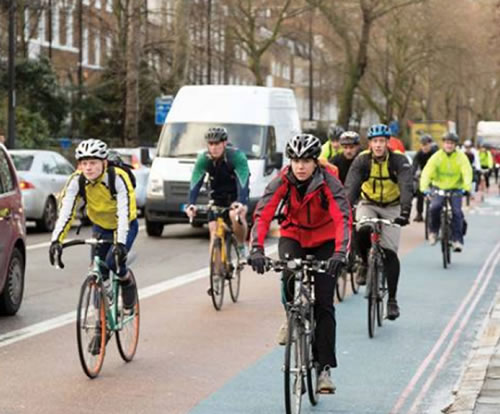Debunking The Myths About Cyclists
As the CS9 debate continues, a local cycling group gives its views

|
The arguments about the merits or demerits of having the Super Cycle Highway have been raging for the past few weeks. The Hounslow Cycling Group has written this list which it says debunks 10 common myths about cycling.
1. Bikes cause pollution and gridlock
Bikes themselves cause no pollution apart from sweat. Bikes and public transport are more space-efficient at moving large groups of people. A road can carry 2,000 cars per hour, or 14,000 cycles. 1 person in a car = 10sq m of highway space; 1 person on a bike = 2 sq m.
40-70% of all trips are under 2 miles; this could easily be done Ė with great health benefits Ė on foot or bike. Every driver who instead takes a bike will cause less pollution and less congestion.
2. Bikes destroy the local economy
Research shows that people on bikes may spend less per visit, but they visit more often. The convenience of cycle parking means that people on bikes may pop into shops in several locations, and also may stay longer - and spend more - as they are not worrying about parking meters. Cyclists tend to spend less on groceries, but more at restaurants, bars and convenience stores.
In terms of parking space, one car park = 6 parked bikes. Traders are surprisingly unreliable on the subject, as research shows they tend to overestimate the percentage of customers arriving by car and insist on the primacy of car parking for shopping. Making Times Square in New York more walkable (against fierce trader opposition) increased sales by 172%.
3. Bikes slaughter pedestrians
In fact cars slaughter pedestrians (and cyclists). From 2006 to 2010 there were 2,798 pedestrian fatalities in the UK. Of these 14 involved a collision with a cyclist or 1 in 200 .
During the period 2005-2014 no pedestrians were killed by red-light jumping cyclists; meanwhile 5 cyclists were killed by red-light jumping cars.
4. Only lycra louts cycle
Cycling has increased by more than 300% since 2000. Not all of them are lycra louts. More men than women and children cycle, as the perception of danger prevents many from braving the roads, which would be an indicator for creating safer lanes.
5. Cycling is too dangerous
Yes, it currently is and thatís why we need to create safe spaces. But overall it is less dangerous than not cycling. Even with current air pollution levels cycling is associated with a lower risk of cardiovascular disease and cancer. If every Londoner walked or cycled 20 minutes a day it would save the NHS £1.7bn in treatment costs over the next 25 years.
6. Driving is much safer than cycling in London
For individuals who shift from car to bicycle, estimates are that beneficial effects are in the range of 3-14 months gain in life-years, while societal benefits are even larger. Car drivers are not protected from particles and noxious chemicals by being enclosed in a car.
7. Cyclists are nasty people who jump the lights and cycle on the pavements
There will always be bad apples who break the rules; we do not make excuses for them. Car drivers break rules, pedestrians cross the road while looking at their phones... The reason cyclists use pavements is sometimes because they donít want to die, sometimes because theyíre lazy or in a hurry; sometimes because they want to save energy; sometimes because the road markings are unclear. If they have their own space and feel less threatened, compliance is far more likely; in central London superhighways, eg. Parliament Square, cycle obedience is high.
The vast majority of vehicle-related pedestrian injuries on the pavement involve a motor vehicle Ė in the years 2005-2014 almost all (98.5%) of footway/verge pedestrian fatalities involved a motor vehicle.However, we also admit that, in conjunction with providing safe cycle routes, there is also an educational element to be done here.
8. Cyclists donít pay tax
Roads and other transport infrastructure are built from general and local taxation. Road tax was abolished in 1937. Vehicle tax is based on emissions, so even if bicycles were liable, there would be nothing to pay. The much-maligned lycra-clad commuters are likely to be tax payers.
9. This isnít Amsterdam
Amsterdam didnít use to be like Amsterdam either. Their streets were as car-choked and congested as Londonís are today but, after over 400 children were killed in traffic accidents in the year 1971, there was a public outcry and they decided to do something about it. The Dutch arenít anti-car Ė they have a higher rate of car ownership per head of population than the UK Ė they just tend to cycle, walk or use public transport for shorter journeys rather than drive everywhere.
10. Cyclists should be licensed
Switzerland used to have this policy, but abolished it in 2010 as the costs far outweighed the revenue. Since stated central and local government policy is to get more people cycling because of the health and environmental benefits, this would be counter-intuitive. It would also be enormously expensive in terms of admin and policing, though as we all know the police are vastly overmanned and have nothing important like terrorism to deal with.
Hounslow Cycling Group
October 15, 2017